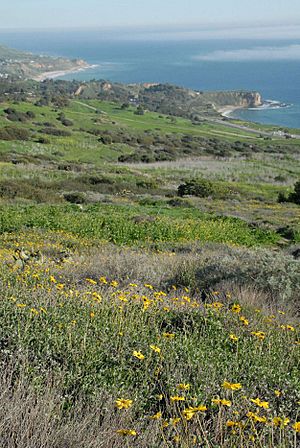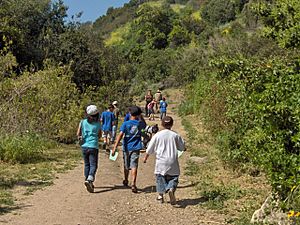Palos Verdes Peninsula Land Conservancy facts for kids
The Palos Verdes Peninsula Land Conservancy (PVPLC) is a non-profit organization that is based on the Palos Verdes Peninsula in southwestern Los Angeles County, California.
Its mission is "Preserving land and restoring habitat for the education and enjoyment of all."
The Conservancy is a land trust and environmental organization to protect natural areas in the Palos Verdes Hills and adjacent coastal Palos Verdes Peninsula areas. Habitats protected include those of the California chaparral and woodlands ecoregion and its Coastal sage scrub and Southern coastal grasslands subregions.
Preserves
Founded in 1988, the Conservancy has protected 1,600 acres (6.5 km2) of open space as nature preserves on the Palos Verdes Peninsula.
White Point Nature Preserve
The White Point Nature Preserve is located in San Pedro and features 102 acres (0.41 km2) of restored coastal sage scrub habitat, hiking and handicap access trails, and a Nature Education Center overlooking the ocean and Santa Catalina Island.
Defense Fuel Supply Point

The Defense Fuel Supply Point in San Pedro provides storage for military fuel reserves and is also home to the endangered Palos Verdes blue butterfly (Glaucopsyche lygdamus palosverdesensis), the “rarest butterfly on earth”. The DFSP mission is a restricted facility which receives, stores, and distributes diesel and jet fuels for military use in California, Arizona and Nevada. Coastal sage scrub is juxtaposed within pipelines and storage tanks, providing habitat for the Palos Verdes blue butterfly as well as the threatened California gnatcatcher (Polioptila californica), a small gray bird that is listed as threatened by the U.S. Fish and Wildlife Service.
Linden H. Chandler Preserve
The Linden H. Chandler Preserve is a 28.5-acre (115,000 m2) property located in Rolling Hills Estates. Owned jointly by the City of Rolling Hills Estates and the Land Conservancy, intensive habitat restoration efforts have added native wildflowers and shrubs to the hillsides. Trails traverse its slopes and grasslands, passing by a recently restored wetland area. The Linden H. Chandler Preserve was created in 1993 through a sale and donation of property by the Chandler heirs, who wanted to see the land preserved in their father's name, who was the founder of Chandler's Palos Verdes Sand and Gravel in Rolling Hills Estates.
Palos Verdes Nature Preserve
The Palos Verdes Nature Preserve is the largest of the Conservancy's preserves consisting of approximately 1,400 acres (5.7 km2) of rolling hills, steep canyons and rock outcrops, with natural habitat and views of the Pacific Ocean and Santa Catalina Island. The City of Rancho Palos Verdes owns most of the land and the Palos Verdes Peninsula Land Conservancy manages the preserve. The preserve is made up of 10 reserves: Abalone Cove Ecological Reserve, Agua Amarga Reserve, Alta Vicente Reserve, Portuguese Bend Reserve, Filiorum Reserve, Forrestal Reserve, Three Sisters Reserve, San Ramon Reserve, Vicente Bluffs Reserve, and Vista Del Norte Reserve.
Lunada Canyon Reserve
The Lunada Canyon Reserve is a 20-acre (81,000 m2) canyon that was given to the Conservancy by the E.K Zuckerman family in 1992. It makes up part of the Palos Verdes Nature Preserve.
George F Canyon Preserve
The 51-acre (206390 m2) George F Canyon Preserve and Nature Center is owned by the City of Rolling Hills Estates, and operated by the Conservancy. A nature trail passes through one of the largest canyons on the Palos Verdes Peninsula. Visitors walk or ride on horseback through willow-riparian and coastal sage scrub habitats, culminating in a view of the Los Angeles Basin.
The George F Canyon Nature Center provides educational and recreational programs which invite the community to enjoy and learn more about the canyon. It provides a variety of changing exhibits so that visitors hopefully see something new with each visit. Exhibits focus on themes such as butterflies, birds of the canyon, insects, plant habitats, animals and wildflowers.
The land for the preserve was contributed to the city of Rolling Hills Estates by Robert and Roland Stein, Sandra Stein Haveson, and Arthur Hale Sr. in memory of David N. Stein, Francis H. Stein, and Marie D. Hale.
Science and education
The Conservancy works to save the landscape from past degradation from urbanization, agriculture uses, and the introduction of invasive foreign species. The goals of the Conservancy's science program are to increase the scientific knowledge base of the Palos Verdes Peninsula through collaborative research. The scientific program focuses on understanding the basic ecosystem functions that define the Palos Verdes Peninsula. Research is conducted both by Conservancy staff and through partnerships with universities, colleges and local agencies.
Research projects inform restoration, conservation, education, and stewardship programs and address the interface between the natural and urban environments. The Conservancy's research program was developed to involve collaborative researchers with the overall goal of increasing the scientific knowledge of the Palos Verdes Peninsula.
Local partnerships
The Conservancy has worked with numerous Eagle Scouts, Girl Scouts and local groups on projects for them to help them achieve their awards while benefiting the local environment. Additionally, the Conservancy fosters partnerships between various local high schools, community colleges, and universities for environmental science and geography-related activities.
Youth Education Program
Partnerships with local schools provide learning opportunities for many students. Youth Education programs include a third-grade nature walk program and projects with high school science classes and scout groups. Through these programs the Conservancy helps young students understand the significance of the Palos Verdes Peninsula's natural areas, empowering them to play a role in its preservation.
Third-Grade Naturalist Program
The Naturalist program consists of a four-part, in-class educational unit covering local ecology, native plants, geology, history, Native-American culture, mammals, reptiles and insects. Lessons are taught by Conservancy educators and trained docents, with assistance from classroom teachers. Samples of plant materials, rocks, animal specimens and other teaching aids help students gain a hands-on understanding and instill an appreciation for nature.
Activities and fundraisers
Palos Verdes Pastoral
Every fall, the Conservancy hosts a dinner inspired by open space in conjunction with Terranea Resort. The event is served under a harvest moon with ocean views in the background, with over 200 guests in attendance annually. Pastoral raises critical funds while highlighting the important role of the community in protecting natural areas.
Nature walks
Every 2nd Saturday, the Conservancy hosts a nature walk in one of its many preserves. Its walk leaders help visitors learn more about the Palos Verdes Peninsula such as the birds, wildlife, and plants that live in the canyons and undeveloped areas, and about the unique geology of the Peninsula. All walks are free.




